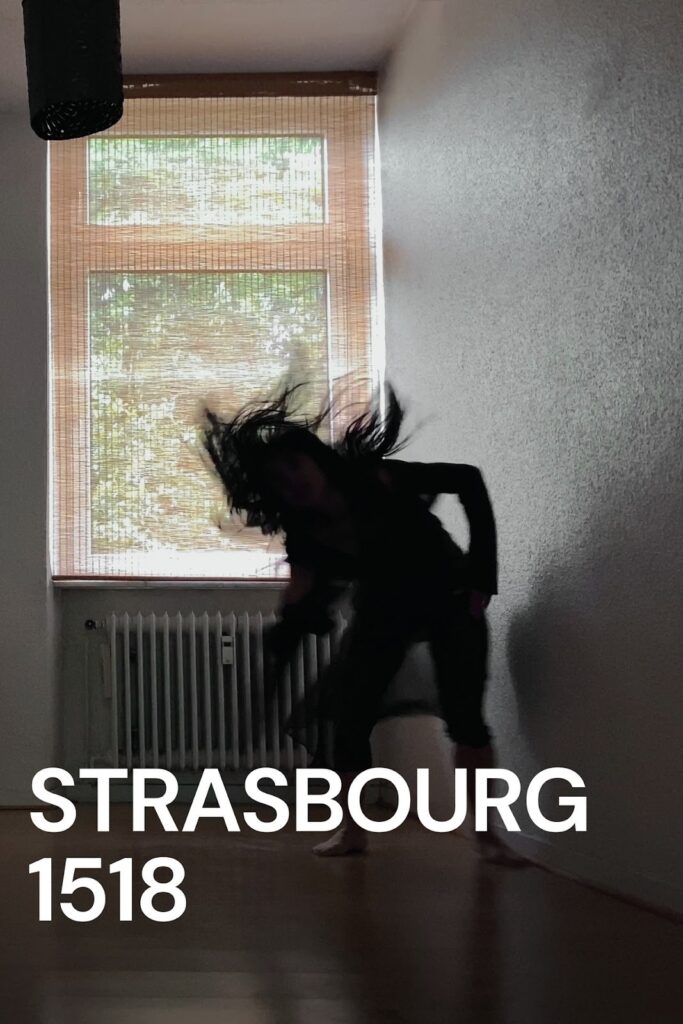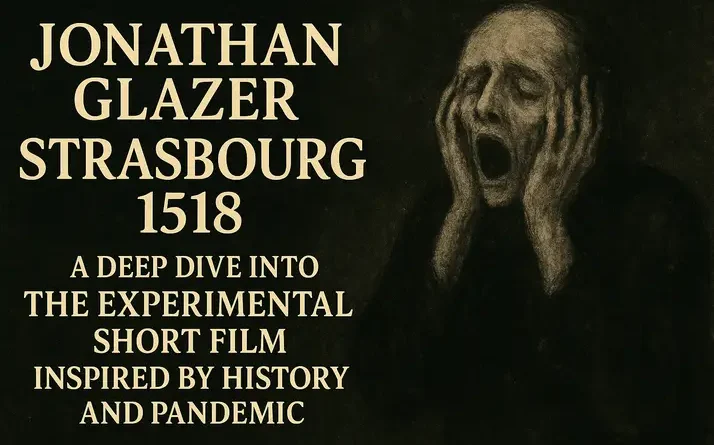Jonathan Glazer Strasbourg 1518: A Deep Dive into the Experimental Short Film Inspired by History and Pandemic
Discover Jonathan Glazer Strasbourg 1518, a gripping 10-minute short film that blends the historical dancing plague with COVID-19 lockdown themes. Learn about its cast, score, and symbolism.
Jonathan Glazer Strasbourg 1518 stands out as a bold short film. It draws from a strange event in history. The dancing plague of 1518 hit Strasbourg hard. People danced without stopping. Glazer turns this into a modern tale. He links it to our own times, like the COVID-19 lockdown.
This film lasts just 10 minutes. Yet it packs a punch. Dancers move in empty rooms. Their bodies twist and turn. Mica Levi’s music drives the beat. It feels raw and real. If you like experimental short films, this one fits right in.
Glazer is known for big films like Under the Skin. Here, he goes small but intense. The film speaks to stress, anxiety, and isolation. It shows dance as a way to cope. Or maybe as a curse. Viewers feel the pull. It’s not a story with a clear plot. Instead, it’s about feeling.
Art-film fans will love it. So will those into contemporary dance. Even if you’re new to this, it’s easy to watch. Just let the moves and sounds take over. You can find Jonathan Glazer Strasbourg 1518 on platforms like MUBI.

Strasbourg 1518
This piece came out in 2020. Right in the middle of the pandemic. That timing makes it special. It reflects quarantine films we all lived through. Let’s break it down step by step.
Who Is Jonathan Glazer? Background and Career
Jonathan Glazer directs films that stick with you. He started in music videos. Then he moved to movies. His style is unique. Bold visuals. Strong sounds. Not much talk.
Born in London in 1965, Glazer grew up loving art. He studied theater design. That shows in his work. Sets are simple but powerful. In Jonathan Glazer movies, every shot matters.
His big break came with Sexy Beast in 2000. It starred Ray Winstone. Critics loved it. Then Birth in 2004 with Nicole Kidman. It was odd but deep. Under the Skin in 2013 made him famous. Scarlett Johansson played an alien. The film used hidden cameras. It felt real and scary.
Glazer also does shorts. Like The Fall in 2019. It’s about mob rule. Then Jonathan Glazer Strasbourg 1518 in 2020. His latest is The Zone of Interest. It won Oscars in 2024. He spoke out in his speech. That stirred talk.
For more on his films, check Jonathan Glazer movies: A deep dive into the director’s iconic films. His net worth comes from hits like these. See Jonathan Glazer net worth.
Glazer’s achievements include awards from Cannes and BAFTA. He works with top talent. Like Mica Levi for scores. His films explore the human mind. Fear. Desire. Control. Strasbourg 1518 fits this. It’s about losing control.
If you’re a fan, watch his oeuvre. Start with shorts. They show his raw side.
What Is the Dancing Plague of 1518 in Strasbourg?
The dancing plague hit Strasbourg in 1518. It was part of the Holy Roman Empire then. In July, a woman named Frau Troffea started dancing. She couldn’t stop. Soon, others joined. Up to 400 people danced day and night.
This wasn’t fun dancing. It was wild. People danced until they fell. Some died from heart attacks or strokes. The town tried to help. They built stages. Hired musicians. But it made things worse.
What caused it? Historians have ideas. One is ergot poisoning. Ergot is a fungus on rye bread. It acts like LSD. Makes people hallucinate. Another theory: overheated blood. Old doctors thought blood got too hot. Caused mania.
Stress played a role too. The time was tough. Famine. Disease. Wars. People felt trapped. Like in mass psychogenic illness. Minds broke under pressure.
The plague lasted months. It stopped in September. No one knows why. Maybe cooler weather. Or just wore out.
This event inspired art. Like Jonathan Glazer Strasbourg 1518. It shows how history repeats. In tough times, bodies react strangely.
For details, read historical theories behind dancing plague epidemic 1518. It’s like Saint Vitus curse or dancing mania. It happened in other places too. But Strasbourg was the biggest.
How Jonathan Glazer Strasbourg 1518 Reflects COVID-19 Lockdown
Glazer made this film during lockdown. Dancers filmed in their homes. Alone. That mirrors quarantine.
In 2020, we all felt stuck. Like the dancers in 1518. Stress built up. Anxiety rose. Isolation hurt. The film shows bodies fighting back. Through dance.
One scene: a dancer washes hands. It’s a COVID nod. We all did that a lot. Rooms are bare. Like minimal set design in short film aesthetics.
Glazer said it’s a “collaboration in isolation.” Dancers from around the world. United by screens. Like us on Zoom.
Themes link old and new. Mass hysteria in the Middle Ages. Now, social media spreads fear fast. The film feels like pandemic short cinema.
Viewers say it helped. Released pent-up feelings. Dance as ritual. To heal or express.
If you lived through lockdown, this hits home. It’s reassuring. We’re not alone in feeling crazy sometimes.
Mica Levi Score in Strasbourg 1518 Film
Mica Levi makes the music pulse. Her score is hypnotic. Electronic beats drive the dancers.
Levi worked with Glazer before. On Under the Skin. Her sounds are eerie. Build tension.
In this film, music starts slow. Then ramps up. Like a heartbeat racing. It makes you jittery. As one review said, like Chaplin in Modern Times.
The score ties to themes. It’s overwhelming. Like hysteria taking over.
Levi is a composer to watch. She scores for films and makes albums. Her style fits experimental works.
For fans, listen to her tracks. They add depth to visuals.
Symbolism of Dance and Hysteria in Strasbourg 1518
Dance here means more than moves. It’s a symbol.
In history, dance was a protest. Against misery. In the film, it’s the same. Bodies rebel against confines.
Dancers clash with walls. Like trapped souls. One draws back a curtain. Shows a street. Dreamlike escape.
Hysteria shows the collective unconscious. We all share deep fears. In lockdown, it surfaced.
Glazer uses visceral imagery. Bodies lurch. Collapse. It’s raw.
Compared to other films. Like The Red Shoes. Endless dance as curse.
This symbolism makes the film deep. For scholars, it’s rich to dissect.
Jonathan Glazer Quarantine Film Full Cast and Production
Cast includes top dancers:
- Andrey Berezin
- Botis Seva
- Ditta Miranda Jasjfi
- Germaine Acogny
- Jamila Johnson-Small
- Kaori Ito
- Nazareth Panadero
- Oleg Stepanov
- Tsai-Chin Yu
They come from different countries. Adds global feel.
Production: Artangel and Sadler’s Wells helped. BBC aired it first. Academy Films produced.
Filmed remotely. In dancers’ homes. Shows home choreography. Domestic confinement.
No big budget. But the impact is huge. Short format suits festivals.
For more on Glazer’s shorts, see The Fall Jonathan Glazer: A deep dive into the haunting short film.
Historical Theories Behind Dancing Plague Epidemic 1518
Let’s list key theories:
- Ergot Poisoning Theory: Fungus on grain. Causes convulsions. Hallucinations. Fits the symptoms.
- Overheated Blood Theory: Old idea. Blood boils from stress. Leads to mania.
- Mass Hysteria: Group mind breaks. From famine, plague fears.
- Saint Vitus Curse: Religious view. The saint punished sinners with dance.
- Stress, Anxiety, Isolation: Modern take. Hard times push people over the edge.
Historians like John Waller studied it. In his book, he says it was psychogenic. Minds caused it, not just bodies.
The event was in Bailiwick of Alsace. Part of Holy Roman Empire. Records show city leaders tried cures. Like bleeding or music.
This adds layers to Jonathan Glazer Strasbourg 1518.
Visceral Imagery in Glazer’s Strasbourg 1518
Glazer’s shots are stark. Dim lights. Empty rooms. Bodies in motion.
One dancer lopes to water. Washes. Echoes ritual.
Editing speeds up. Stroboscopic. Feels chaotic.
It’s like isolation art. Restricted performance.
Glazer masters this. In his films, images burn in.
For similar reasons, watch his other works. Like Birth Jonathan Glazer: A simple guide to the 2004 film.

A dancer in motion from Strasbourg 1518
Short Experimental Film Inspired by Pandemic Isolation
This film is experimental. No clear story. Just feeling.
It suits short film aesthetics. Quick but memorable.
Made in pandemic. Shows how art adapts.
Other quarantine films exist. But this stands out. With dance and history mix.
Strasbourg 1518 Streaming Platforms and Availability
Watch it on MUBI. Link: MUBI Strasbourg 1518.
Also on BBC iPlayer sometimes. Or YouTube trailers.
For reviews, see Letterboxd: Letterboxd Strasbourg 1518.
Guardian has a great review: Guardian Review.
Jonathan Glazer Strasbourg 1518 Short Film Review
Critics praise it. The Guardian calls it “cathartic spasm.” Feels like protest.
MUBI users rate 7.1/10. From over 6,000 votes.
One review: “Pure intensity.” Another: “Speaks to lockdown rage.”
It’s for art-house crowds. Not mainstream. But rewarding.
If edgy, try it. It’s short. Won’t take long.
For Glazer’s Oscar talk, read Jonathan Glazer’s Oscars speech: What he said and why it matters.
Target Audience for Jonathan Glazer Strasbourg 1518
Who watches this? Art-film fans. They follow directors like Glazer.
Contemporary dance lovers. They get the moves.
Critics and students. They dig symbolism.
Socially aware viewers. See pandemic links.
Glazer fans. Know his style.
Ages 20-50. Educated. Urban. Watch on MUBI or festivals.
They expect ambiguity. Intensity. Not plot.
Challenges: Too abstract for some. But that’s its charm.
Related Works and Influences
Glazer’s film ties to others. Like Climax by Gaspar Noé. Wild dancing.
Or The Devils by Ken Russell. Hysteria themes.
Music like Florence + The Machine’s Choreomania.
For more on Glazer, see Jonathan Glazer.
Conclusion: Why Jonathan Glazer Strasbourg 1518 Matters Today
Jonathan Glazer Strasbourg 1518 blends old history with new fears. The dancing plague of 1518 shows human limits. Glazer updates it for COVID-19 inspiration film. With Mica Levi’s score and strong dances, it’s a must-see experimental short film.
It reminds us: In hard times, art helps. Dance frees us. Even in isolation.
What do you think caused the 1518 plague? Share in the comments.

